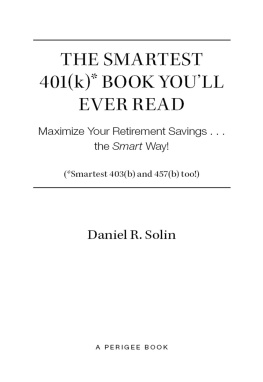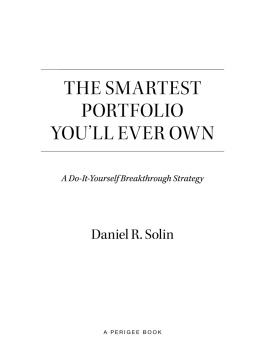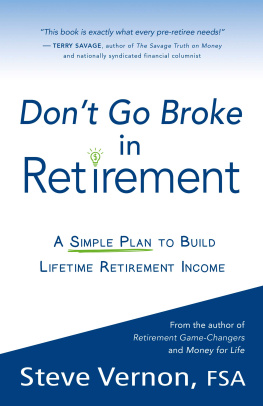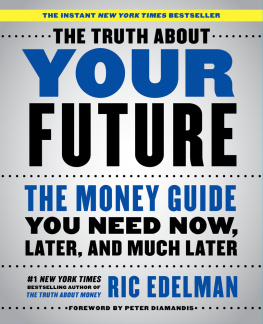THE SMARTEST 401(k)* BOOK YOULL EVER READ
Maximize Your Retirement Savingsthe Smart Way!
(*Smartest 403(b) and 457(b) too!)
Daniel R. Solin
A PERIGEE BOOK
A PERIGEE BOOK
Published by the Penguin Group
Penguin Group (USA) Inc.
375 Hudson Street, New York, New York 10014, USA
Penguin Group (Canada), 90 Eglinton Avenue East, Suite 700, Toronto, Ontario M4P 2Y3, Canada (a division of Pearson Penguin Canada Inc.)
Penguin Books Ltd., 80 Strand, London WC2R 0RL, England
Penguin Group Ireland, 25 St. Stephens Green, Dublin 2, Ireland (a division of Penguin Books Ltd.)
Penguin Group (Australia), 250 Camberwell Road, Camberwell, Victoria 3124, Australia (a division of Pearson Australia Group Pty. Ltd.)
Penguin Books India Pvt. Ltd., 11 Community Centre, Panchsheel Park, New Delhi110 017, India
Penguin Group (NZ), 67 Apollo Drive, Rosedale, North Shore 0632, New Zealand (a division of Pearson New Zealand Ltd.)
Penguin Books (South Africa) (Pty.) Ltd., 24 Sturdee Avenue, Rosebank, Johannesburg 2196, South Africa
Penguin Books Ltd., Registered Offices: 80 Strand, London WC2R 0RL, England
While the author has made every effort to provide accurate telephone numbers and Internet addresses at the time of publication, neither the publisher nor the author assumes any responsibility for errors, or for changes that occur after publication. Further, the publisher does not have any control over and does not assume any responsibility for author or third-party websites or their content.
Copyright 2008 by Daniel R. Solin
All rights reserved.
No part of this book may be reproduced, scanned, or distributed in any printed or electronic form without permission. Please do not participate in or encourage piracy of copyrighted materials in violation of the authors rights. Purchase only authorized editions.
PERIGEE is a registered trademark of Penguin Group (USA) Inc.
The P design is a trademark belonging to Penguin Group (USA) Inc.
The Library of Congress has cataloged the Perigee hardcover edition as follows:
Solin, Daniel R.
The smartest 401(k) book youll ever read: maximize your retirement savingsthe smart way!: (smartest 403(b) and 457(b), too!) / Daniel R. Solin.
p. cm.
Includes bibliographical references.
ISBN: 1-101-45804-6
1. 401(k) plans. 2. Defined contribution pension plansUnited States. 3. Retirement incomeUnited StatesPlanning. I. Title.
HD7105.45.U6S65 2008
332.024'0145dc22
2008006437
PUBLISHERS NOTE: This publication is designed to provide accurate and authoritative information in regard to the subject matter covered. It is sold with the understanding that the publishers is not engaged in rendering legal, accounting, or other professional services. If you require legal advice or other expert assistance, you should seek the services of a competent professional. Continued on .
CONTENTS
PART ONE
Rules for All Investments
PART TWO
401(k) Plans: Rigged to Rob Your Nest Egg
PART THREE
How to Beat a Rigged 401(k) System
PART FOUR
The Care and Feeding of Your IRA
PART FIVE
403(b) Plans and AnnuitiesThey Make 401(k) Plans Look Good!
PART SIX
Alternatives to Traditional Retirement Plans
PART SEVEN
The Closing Argument
Navigating the 401(k) Minefield
I wish I could accuse Congress of merely dithering on much needed 401(k) reform. The reality is that nothing on the regulatory horizon will address the core problems of a broken and corrupt system.
Its actually getting worse since this book was first published in June 2008. Because of the stock market crash, the average 401(k) plan participant had less money in her plan at the end of 2008 ($45,000) than she did in 1998! And she didnt have much thenonly $47,000.
By some estimates, more than 33 million retirees are in danger of living their retirement in poverty. Whether these retirees and others to follow will be able to rely on Social Security and Medicare is unclear. Both programs are vastly underfunded. Social Security is underfunded by $10 trillion and Medicare is facing shortfalls between $65 and $85 trillion. These are scary numbers.
The 401(k) System Is Still Fundamentally Flawed
All of the problems with 401(k) plans I noted in mid-2008 remain unchanged. They continue to be a giant skimming operation, where brokers and mutual funds act in concert with employers to deprive employees of market returns that are theirs for the taking.
Most employers still sell out the best interest of their employees, by taking what amounts to a payoff from brokers who agree to subsidize the administrative costs of the plan. In exchange for their free plan, employers agree to let brokers select the investment options available to plan participants. No good can come of such an arrangement and none does.
The broker has hit the lottery. In exchange for paying for the administrative costs of the plan, he gets a monopoly on selecting the mutual funds for the plan. How does he make this selection? He accepts revenue-sharing payments from mutual funds. Those funds that pay get into the plan. Those that dont are shut out. More than 90 percent of plan advisors take these kickbacks, which are rarely disclosed.
What kind of mutual funds participate in this scheme? Actively managed (I call them hyperactively managed) funds, which attempt to beat a designated benchmark, like the S&P 500. Typically, low-cost, outperforming index funds will not pay revenue-sharing. The leader in low-cost index funds, Vanguard, falls into this category. According to its director for institutional sales, when brokers realize they wont be compensated for placing our funds in a plan, they will typically hang up on us.
Some of the abuses are really striking. Most mutual funds have two classes of shares: investor shares and institutional shares. The only difference is the cost charged by the fund family for operating each share class, which is deducted from investors returns. Institutional shares typically require a higher minimum investment of $500,000 or more. These shares charge less than investor shares, which have far lower minimums. Lower fees are directly correlated with higher returns.
While most individuals cannot meet the minimum required to purchase institutional shares, many 401(k) plans can do so by aggregating the purchases of plan participants.
The savings to plan participants can be significant. For example, in a class action against Wal-Marts 401(k) plan sponsor, the plaintiff alleged that Wal-Mart cost plan participants $60 million in unnecessary expenses over a six-year period by not insisting on institutional shares rather than investor shares of the mutual funds in Wal-Marts 401(k) plan.
Everyone Winsbut Employees
Everyones a winner in this cozy, secretive systemexcept employees. They are frequently deprived of access to low-cost, higher-returning index funds. Their plans have much higher costs than plans where no subsidies or revenue-sharing payments are paid.
The consequences of high costs can be devastating. According to the Department of Labor, a 1 percent difference in costs can reduce your account balance at retirement by a whopping 28 percent.
Dont expect your employer to take the rowing oar in reducing plan expenses. Remember, the plan is free to them. One study estimated that 78 percent of plan sponsors did not even know their plan costs. Why should they care? You are paying these costs.
Rome Burns While Congress Dithers
Clearly, this is a system ripe for regulation. So what is Congress doing to curb the excesses that will likely cause millions of retirees to spend their golden years in poverty?
Not much.









